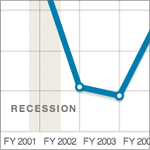States Replenish Reserve Funds - but Slowly
These data have been updated. To see the most
recent data and analysis, visit Fiscal 50.
Half of the states expected to have enough of a financial cushion to cover at least 23 days of operating expenses by the end of fiscal year 2014, a partial rebound from levels before the Great Recession.
In the five years since the end of the recession, the median number of days that states could run just on their reserves and balances has risen in a sign of improving financial health in states. But at the end of fiscal 2014, total balances still were expected to be 18 days short of the median financial cushion of 41 days in fiscal 2007, just before the downturn. Download the data.
Only 12 states estimated that their reserves—counting both rainy day funds and end-of-year general fund balances—would exceed their 2007 levels, measured in days of operating expenses.
After four straight years of increasing reserves, the 50-state median dropped from the previous year. But the latest results are estimates made before the 2014 budget year ended, for most states in June, and are likely to change once states officially close their books. In recent years, final figures have been higher than estimates, given that it is difficult for states to pinpoint ending balances before all of their bills are paid and revenue is collected. The estimates also were made before a number of states had an unexpected drop in personal income tax collections for April that reduced their cash balances.
Most Days of Operating Expenses in Reserve, FY 2013 |
|||
| Alaska | 794 days | ||
| North Dakota | 307 days | ||
| Wyoming | 194 days | ||
| West Virginia | 122 days | ||
| Nebraska | 122 days | ||
|
Source: Pew analysis of data from the Fiscal Survey of States, Fall 2013, published by the National Governors Association and the National Association of State Budget Officers |
|||
According to states’ estimates for fiscal 2014:
- Four states had more than 100 days of operating costs in reserves—Alaska (642 days), Wyoming (189 days), North Dakota (154 days), and West Virginia (119 days).
- The smallest reserves—with less than five days’ worth of operating costs—were in Arkansas (0 days), Illinois (1.8 days), Pennsylvania (2.8 days), and New Jersey (3.3 days).
- At least six states expected for the second year in a row to have fewer days’ worth of operating expenses in reserve than they had in fiscal 2009, the end of the recession and the low point for overall state reserves and tax revenue. They are Illinois, Louisiana, Massachusetts, Mississippi, New Jersey, and New York.
- On a positive note, for the second straight year no state expected its reserves and balances to drop below zero. After the recession, Arizona, California, Connecticut, Kansas, Oregon, Pennsylvania, and Washington emptied their reserves in at least one year, requiring them to borrow or transfer cash to cover operating costs.
States use reserves and balances to manage budgetary uncertainty, deal with revenue forecasting errors, prevent severe spending cuts and tax increases, and cope with unforeseen emergencies. Building up reserves and balances is a sign of fiscal recovery, but there is no one-size-fits-all rule on when, how, and how much to save. States with a history of high revenue volatility or severe economic swings may desire larger cushions.
Because reserves and balances are vital to managing unexpected changes and maintaining fiscal health, their levels are tracked closely by bond rating agencies. For example, Moody’s Investors Service recently cited Virginia’s financial cushion as a key component of its top credit rating.
This measure does not take into account additional resources that some states may have available to soften downturns, such as balances outside of their general funds or rainy day accounts, so it may not reflect a state’s complete fiscal cushion. In addition, some states undertake considerable spending outside of the general fund, so comparisons across states should be made with caution.







